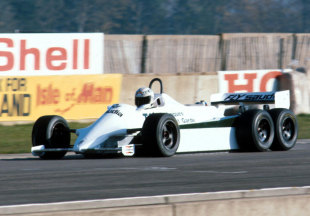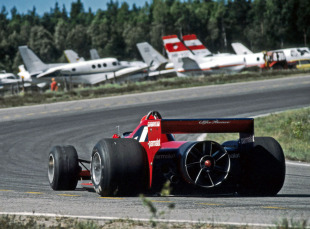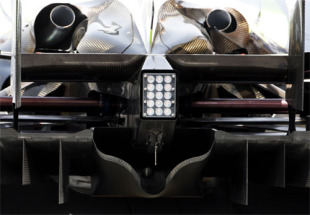With teams looking to find a way around the ban on exhaust-blown diffusers in 2012, we look back at ten of the most interesting ideas to be banned in F1

Alan Jones tests the six-wheeled, four-wheel drive Williams FW07D shortly before such innovations were banned © Sutton Images
Enlarge
Four-wheel drive
The first proper attempt to bring four-wheel drive into Formula One came in 1961 with the Ferguson P99. The brainchild of legendary tractor producer Harry Ferguson, the P99 was built to show off four-wheel drive's potential for use on the road. However, it was badly timed as another revolution was taking place in F1 with the introduction of mid-engined cars and the latter proved to be a much cheaper source of performance. The front-engined Ferguson was also designed for a 2.5-litre engine, but by the time it was ready for competition the rules had restricted capacity to just 1.5 litres. As a result the P99 was something of a flop, although it did win one race in the wet at Oulton Park in the hands of Stirling Moss. The next four-wheel drive cars in Formula One were of a different breed with the mid-engined Lotus 63, Matra MS84, McLaren M9A and Cosworth F1 car - all of which were quickly abandoned in the late 1960s. Four-wheel drive F1 cars evolved again in the early 1980s when Williams started experimenting with a six-wheel car, the rear four wheels of which were driven. Team boss Patrick Head reportedly said the idea was dropped when "someone in a FOCA meeting said it would drive up costs and cause chaos during pitstops". The FIA banned four-wheel drive cars soon after and limited the number of wheels on a car to four.
Mass damper
At the end of the 2005 season, Renault came up with a new concept to control the pitch of the car as it rode over bumps. Essentially it consisted of a sprung damper, about the size of a small cake tin, in the nose of the car to counteract the forces on the tyres. For 2006 Renault developed the system at the rear of the car and got the whole system signed off by the FIA for use in competition. It proved hugely successful and by mid-season the other teams had cottoned on to the idea and either developed their own versions or started to question its legality. At the German Grand Prix the stewards declared the system legal, but their decision was later overruled by the FIA, which said the mass damper was a moveable aerodynamic device. It was banned from the Turkish Grand Prix onwards which handed Renault's main rivals Ferrari an advantage in the remaining races, although Renault still came out on top.
Ground effects
Like many innovations in Formula One, ground effects were pioneered by Colin Chapman's Team Lotus. The idea was to create low pressure under the car that would suck it to the ground and improve cornering speed using the science behind Bernoulli's principle. The most efficient way of achieving this was by running skirts along the side of the car to seal the area of low pressure underneath it. The success of the Lotus 79 in 1978 prompted the other teams to copy and refine the design, which in turn led to increasingly dangerous cornering speeds. The governing body eventually banned skirts in 1980, but the necessary safety measure got caught up in the politics of the ongoing power struggle between FISA (the governing body) and the Formula One Constructors' Association (FOCA). In response to the ban, which would have seen the FOCA teams become uncompetitive, Brabham's Gordon Murray found a loophole in the rule which meant the car's ride height and floor only had to be legal in the pit lane. As a result he designed hydraulic suspension on the Brabham BT49C that could be lowered into place once the car was on track. Rather inevitably, the other teams followed suit in the pursuit of downforce, but soon the cars were becoming less and less drivable. "They have to change," Didier Peroni told journalist Nigel Roebuck. "I feel so stupid when I'm in the car, raising the suspension for the test in the pits, in front of all the spectators. How ridiculous! As for driving, there's no feel in the cars now they have no suspension movement. They are brutal to drive." FISA re-legalised ground effects in 1982 but huge accidents, resulting in the death of Gilles Villeneuve and the end of Pironi's career, moved the governing body to introduce a full and enforceable ban in 1983.

The Brabham BT46B romped to victory at the 1978 Swedish Grand Prix © Sutton Images
Enlarge
Fan car
One off-shoot of ground effects was the Brabham BT46B - also known as the 'fan car'. The concept was to fit a giant extractor fan - ostensibly for cooling - to the back of the car to lower the pressure underneath further. It proved hugely successful on its debut at the Swedish Grand Prix in 1978 but drew complaints from other teams - and from drivers who said the fan had blown stones and other debris at them during the race. In the knowledge that FISA would almost certainly ban the car, Brabham boss Bernie Ecclestone agreed to ditch the concept despite its very obvious benefits.
Brake steer
In 1997 McLaren came out of its mid-1990s slump with a car capable of winning races. The addition of Adrian Newey to the design team undoubtedly helped, but a novel concept that used rear-wheel braking to help turn the car into corners added to the MP4-12's competitiveness. The team were keen to keep the system, which featured a third pedal in the cockpit, under wraps but its plans were foiled at the Luxembourg Grand Prix. Both cars had been leading but retired within a lap of one another and photographer Darren Heath pounced on the opportunity to stick his camera in the cockpit. When his photos were developed they revealed the third pedal and the pictures were duly published in F1 Racing magazine, revealing the system to the paddock and beyond. McLaren stuck with the technology, but in early 1998, when the McLaren's started to look unbeatable, main rivals Ferrari protested and got the system banned on the grounds that it was primarily a steering system. Nevertheless, McLaren has recently put the technology back into use on its MP4-12C road car.
Active suspension
Active suspension first appeared on an F1 car in 1987 on the Lotus 99T. It was the culmination of almost a decade of research which had been set in motion by F1's great innovator Colin Chapman before his death. The system was designed to adapt the suspension to the road ahead, flattening out the car's ride for both handling and aerodynamic purposes. On two of the bumpiest tracks it appeared to work a treat, with Ayrton Senna winning at Detroit and Monaco, but the system was also heavy and Lotus eventually ditched it at the end of the season. Williams then took up the mantle and by 1992 had a fully-active system that could be pre-programmed to react to the bumps at any particular circuit. The fully-active Williamses were so successful that the rest of the grid started working on their own systems, but the FIA banned it along with traction control and ABS ahead of the 1994 season.
Moveable aero
In the late 1960s teams started experimenting with wings in order to create downforce. Early examples were notoriously fragile and several accidents had devastating effects. Work into moveable aerodynamics - not a million miles away from today's Drag Reduction System - proved particularly dangerous and in 1970 the governing body stepped in to regulate the use of aerodynamics in Formula One. The location and size of the wings were limited and moveable aero was prohibited. Since then several other innovations, such as flexi-wings and mass dampers, have fallen foul of the ban put in place in 1970.

Double diffusers became an intense battle ground before they were banned in 2011 © Sutton Images
Enlarge
Double diffuser
In an attempt to boost the chances of overtaking, the FIA completely overhauled the rules regarding aerodynamics in 2009 but in doing so left a loophole open. Several teams spotted the potential to add another layer to the diffuser at the rear of the car, but most considered it against the spirit of the regulations and expected it to be ruled illegal. Only Williams, Toyota and Brawn were brave enough to act on it and, to the others surprise, they were rewarded. The Brawn system proved particularly effective and the team won six of the first seven races. The FIA decided against banning the concept in 2009, prompting the other teams to copy the design. However, at the start of 2010 the FIA changed its mind and announced double diffusers would be banned in 2011.
F-duct
Modern F1 engineers are constantly looking for the most efficient trade off between downforce and drag when designing a car's aerodynamics. One of the greatest producers of both drag and downforce on an F1 car is the rear wing, but the regulations make it hard to find an advantage in that area. However, in 2010 McLaren came up with a system consisting of series of pipes running through the chassis that, at the driver's request, could change the airflow over the rear wing in order to stall it and reduce drag. The performance advantages were plain to see when the car hit the track and the other teams quickly looked into copying the system. However, retro-fitting an F-duct proved tricky and few perfected the system by the end of 2010 when the teams agreed to ban it for 2011. The origins of the name are still something of a mystery - with McLaren naming it a J-switch internally - but are believed to be because the original inlet for the F-duct on the McLaren was placed near the 'F' on its Vodafone sponsorship.
Sidepod-mounted wing mirrors
Mirrors are useful things on a racing car, but from an aerodynamicist's perspective they can also be a bit of a drag. Chunky pieces of carbon fibre protruding from the edge of the cockpit don't do a huge amount for aerodynamic efficiency and in 2006 Ferrari decided to place its mirrors on specially-shaped stalks on the sidepods. Several teams soon copied the concept and by 2010 half the grid was using some variant of out-board mirrors to clean up the airflow to the rear of the car. The only problem was that drivers complained the distant mirrors were wobbling excessively and such comments prompted the FIA to take action and ban them at the 2010 Chinese Grand Prix. Mirrors now have to be mounted next to the cockpit, although vibrations are still a problem.Laurence Edmondson is an assistant editor on ESPNF1
© ESPN Sports Media Ltd.
Laurence Edmondson

 Laurence Edmondson is deputy editor of ESPNF1 Laurence Edmondson grew up on a Sunday afternoon diet of Ayrton Senna and Nigel Mansell and first stepped in the paddock as a Bridgestone competition finalist in 2005. He worked for ITV-F1 after graduating from university and has been ESPNF1's deputy editor since 2010
Laurence Edmondson is deputy editor of ESPNF1 Laurence Edmondson grew up on a Sunday afternoon diet of Ayrton Senna and Nigel Mansell and first stepped in the paddock as a Bridgestone competition finalist in 2005. He worked for ITV-F1 after graduating from university and has been ESPNF1's deputy editor since 2010

